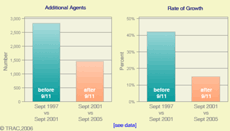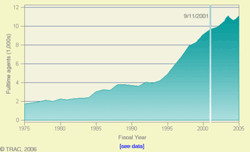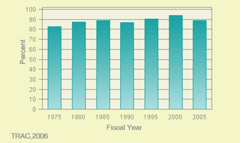Analysis of detailed government staffing data by the Transactional Records Access Clearinghouse indicates that the events of 9/11/01 had only a modest impact on the overall size of the U.S. Border Patrol and how its agents were distributed around the nation.
While the number of the agents policing the borders is now more than twice what it was a decade ago, much of this increase occurred in the years before 9/11 and the agency's growth rate since the cataclysmic events has actually slowed. See Figure 1 and supporting table.

Figure 1. Click for larger image |
Another key finding is that even with the significant overall increase in agents, the percent of the total assigned to working along the border with Canada in 2005 actually is less than it was thirty years ago. The obverse, of course, is that the proportion of agents on the border with Mexico is now higher than it was in 1975. See Figure 2 and supporting table.

Figure 2. Click for larger image |
The core mission of the Border Patrol, one part of Customs and Border Protection within the Department of Homeland Security, is to "safeguard the American homeland at and beyond our borders." The agency's primary focus is on apprehending persons attempting to enter the United States by slipping across its 8,000 miles of land and water borders. A second distinct division of Customs and Border Protection is its inspectors who regulate the flow of U.S. citizens and others at more than 300 designated ports of entry.
The proper functioning of both components of the Department of Homeland Security has been one aspect of the continuing political debate over the Bush Administration's handling of the terrorism threat. But the national discussion also has been fueled by the passionate belief of those Americans who are concerned that the inward flow of all aliens -- legal and illegal -- threatens the basic values of the United States.
This report, however, focuses entirely on an examination of the overall size of the Border Patrol and division of its agents between the northern and southern borders. Since our government was formed, the actual size of federal agencies usually was determined as the result of complex negotiations between the White House and Congress. This is still true today. While deciding a second important staffing question -- where the employees actually will work -- is generally left up to the executive branch, powerful members of Congress also can influence deployment outcomes.
(A separate report analyzing the relationship of border patrol agents to apprehensions reported by the government -- a central responsibility of the Border Patrol -- can be viewed at this link.)
National Trends
During the last thirty years, there has been a six-fold increase in the overall size of the Border Patrol, with full-time employees jumping from 1, 746 in 1975 to 11,106 in September of 2005. It thus is clear that in a broad way Congress and a long line of presidents have favored the expansion of the agency. And a recent White House analysis of the FY 2007 budget re-stated the Bush Administration's previous statements that it was fully committed to providing the resources required to build "smarter and more secure borders." A key aspect of the broad effort outlined in the budget was a request to Congress for some additional border patrol agents in the coming year. See Figure 3 and accompanying table.

Figure 3. Click for larger image |
But data collected by the Office of Personnel Management show that over the years the growth of the agency has varied. Since 1993, for example, the annual growth rate in the number of full-time Border Patrol agents was higher in both the first and second Clinton terms than it so far has been in the Bush years.
Here are the numbers. In the four years proceeding 9/11, the data show that full-time Border Patrol agents increased from 6,817 in 1997 to 9,651 in 2001, a 42% jump. By comparison, in the four years following the attacks, they increased from 9,902 in 2002 to 11,106 in 2005, an increase of only 15%. See earlier Figure 1 and supporting table.
A more limited analysis looking at staffing counts over shorter time periods also suggests the rhetoric for enlarging the Border Patrol has not matched actual funds provided. In March 2004, for example, the agency reached its maximum size with 11,110 full-time agents, shrinking slightly to 10,628 agents at the end of December 2004. The most recent available data shows that in September of 2005 this slight dip had reversed itself and the total number of agents has almost returned to its March 2004 level but not managed to move any higher. See Figure 3 and supporting table.
North/South Distribution
In the immediate wake of 9/11 the question about whether the border with Canada was adequately protected was raised by some congressmen and local officials.
This concern has not disappeared. In its final report published in July of 2004, for example, the 9/11 Commission joined in criticizing the government for failing to add to the Border Patrol agents assigned to the northern border.
"Despite examples of terrorists entering from Canada, awareness of terrorist activity in Canada and its more lenient immigration laws, and an inspector general's report recommending that the Border Patrol develop a northern border strategy," the commission said, "the only positive step was that the number of Border Patrol agents was not cut any further."
But a detailed analysis of Border Patrol personnel data indicates the Bush Administration and Congress have not taken the commission's recommendation to heart. Although there have been modest changes, the analysis indicates that in the main the nation's concern about stopping the illegal immigrants coming from Mexico has trumped the commission's worry about terrorists slipping into the United States from Canada. This is true despite the Border Patrol's new national strategy issued September of 2004 which in defining its "Strategic Focus" ... " recognizes that the geographic distinctions along the Northern Border yield a much greater vulnerability for terrorist border-crossing attempts."
While agents of the Border Patrol are still predominantly assigned to duty stations along the border with Mexico -- there currently are 28 times more of them facing south than north per border miles guarded -- there indeed have been modest changes. In 2001, for example, 93.9% of the agents were located along the border with Mexico. Today 88.8% are assigned to this border. In 2001 3.4% of the agents were along the border with Canada. In 2005 the proportion was had grown to 8.8%. The total working at locations other than the north and south went from 2.7 to 2.4%. See earlier Figure 2 and supporting table.

Figure 4. Click for larger image |
In summary, in terms of total the number of agents working on the two borders in the post 9/11 period, personnel on the southern border went down by about 5 percentage points while those on the northern border went up by 5 percentage points. This means the percentage on the northern border has climbed back to what it was in 1989 and was significantly lower than where it was in 1975 when border patrol agents on the northern border made up about 13% of the total. See Figure 4 and supporting table.
Another perspective can be gained by examining how the new agents hired by the Border Patrol in the last few years have been divided between the two borders.
Growth in Northern vs Southern Border |
During the four years since 9/11, the agency grew by 1,455. For the whole period, 796 of the new hires (55%) went to southern border while 649 (45%) went to the northern border.
Examined on a year-to-year basis, however, the four-year data show the allocation between north and south was quite erratic. In the second year after 9/11, a net of five out of six of the new recruits went to the southern borders. This was reversed in the third year after 9/11 with the net new recruits on the southern border actually showing a decline. But in the most recent available year, the distribution was again reversed and only 8 of the 379 net new border agents going to the northern border. See table.
Conclusion
Information about the number and distribution of government agents is essential for understanding what the government does. It also is important for judging the extent to which the governors -- in this case the president and Congress -- are living up to their public promises. So, examining how many Border Patrol agents the government employs today and how many it employed yesterday and how many it will employ tomorrow and where they are working is critical for oversight and the working of a representative democracy.